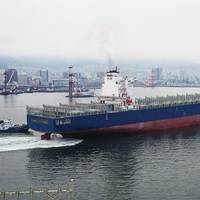Pull the Handle Down...

One of the most effective and easiest fuel reduction operations is reducing the engine power by reducing the speed of a vessel. Out of the total operational costs of a vessel, fuel costs account for, by far, the highest proportion. When fuel prices soared, the technical experts of one of the world’s biggest shipping companies set about to solve the problem, and slowing down was the solution they devised. By 2009 significant fuel savings resulted from sailing its ships at 12 knots instead of 24, and ”Slow Steaming” officially became the standard operating procedure in their fleet.
Slide Fuel-Valves Pass Noteworthy Milestone
First introduced at the turn of the millennium, MAN PrimeServ – MAN Diesel & Turbo’s service division – recently retrofitted its 20,000th slide fuel-valve. Slide fuel-valves come as standard on all new MAN B&W engines but can also be retrofitted on MC engines. The slide fuel-valve eliminates the so-called "sac volume," which reduces fuel-oil consumption and, furthermore, eliminates dripping from the fuel-valve nozzle. Compared to conventional valves, the slide fuel-valve has NOx-reduction potential. According to MAN, the reduced sac volume leads to an improved combustion process, resulting in fewer deposits throughout the gas ways and a reduction in overall emissions, such as HC, NOx and particulate matter.
Slide Fuel-Valve a MAN Success Story

First introduced at the turn of the millennium, MAN PrimeServ – MAN Diesel & Turbo’s service division – recently retrofitted its 20,000th slide fuel-valve. Christian Ludwig – Head of Retrofit & Upgrade – MAN Diesel & Turbo, said: “Slide fuel-valves have proved to be very popular within the marine, two-stroke market. Really, it’s a case of having introduced the right technology at the right time and the slide fuel-valve’s strong market performance is testimony to the fuel savings and increased environmental profile it brings to working vessels.







